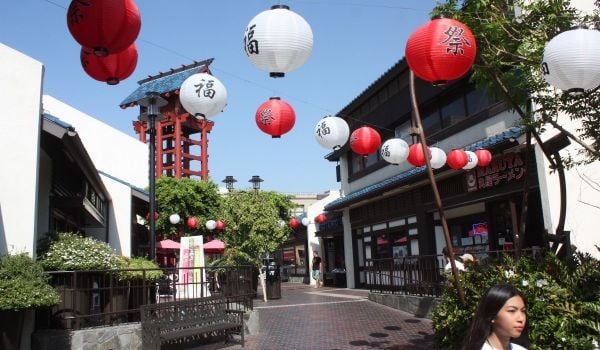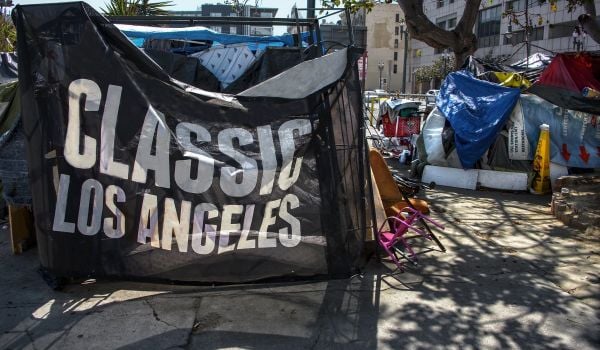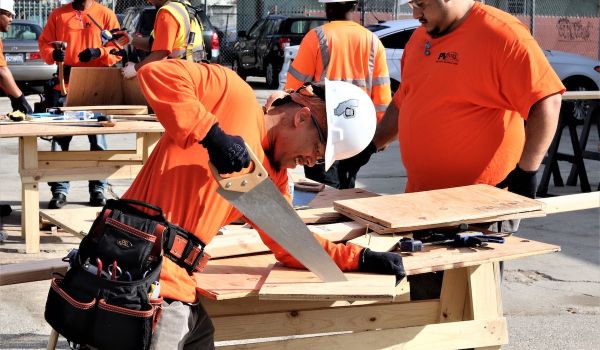Elysian Park is Los Angeles’ oldest public park and, at 575 acres, the second largest in the city. For residents Dante Iniguez and Anthony Martin, it was a favorite spot for typical park activities — picnics and walks — until they came across a project called Test Plot by Terremoto, a self-described “adventurous” landscape architectural design studio.
At first glance, the Test Plot looks just like a circle of fenced-off green space, about 30 feet in diameter, on a hill along the northern end of the semi-wild Elysian Park below Dodger Stadium. But look closer, and you see the first white blooms of native sage and bright yellow Monkeyflowers. Terremoto envisioned the plot as an experiment in restoring native plant ecology, not least because the park’s maintenance has been neglected for decades. “The ecological condition of our beloved park is in a sad state,” Terremoto states on its website. “There are rampant invasive species, dead and dying trees, and very few communities of diverse native plants left.”
The solution: Bring in the people who care the most about the park, the locals. Iniguez and Martin now visit every weekend, watering and weeding. They’re learning about California native plants growing at the plot – like datura, coyote brush and Yerba Santa — and feel stewardship of the park. “It’s this idea of the land being for the public,” Martin says, “And that we can take ownership of the care of the land.”

A small plot in Elysian Park has grown into a large idea (Photo courtesy of Terremoto)
What began as a simple, grassroots experiment in 2019 is now in four L.A. parks and one campus, overseen by a growing group of volunteers, students and landscape architects. There is a zine for people who want to start their own, with Test Plots now popping up as far away as Belgium. “Every location we’ve done so far has been so different, but they’re all working,” says Jenny Jones, a Terremoto partner. “We are trying to be really agile, trying to meet communities where they’re at.”
Jones was one of a few Terremoto employees who lived near the park. They started talking with community groups Saturate CA and Citizens Committee to Save Elysian Park about getting permission from the city to experiment in restoring the native ecology, given Elysian’s long history of under-resourcing and under-maintenance. The goal was to “pierce the bureaucracy,” as Jones put it, so they could start a plot with minimal red tape and keep it running with volunteer help, as opposed to park staff.
The city offered permission to start a “temporary garden,” according to Jones, “meaning that we didn’t have to go through all the normal channels of approvals.” The city park staff was eager for help — in Los Angeles, and in cities around the country, park budgets have been significantly cut, which often results in neglected green infrastructure and rampant invasive species.
The Elysian plots were planted in the winter of 2019 with several concepts to test, namely the minimal time, energy, capital, botanical and material inputs required to start addressing the park’s ecological imbalance, as well as ways to build the community volunteer infrastructure to lead the maintenance.
The Test Plot shape was informed by the throw of a sprinkler to make watering as easy as possible. Terremoto organized volunteer planting and weeding days and signed up volunteers like Iniguez and Martin for weekly maintenance. They tested a variety of native plants within different microclimates. For the first year at Elysian, monkeyflower, sages and yerba buena flourished while gophers decimated many of the grasses.
With the Elysian Park Test Plots underway, Jones began talking with landscape architect and University of Southern California lecturer Jennifer Toy about expansion, due to Toy’s background in community engagement and interest to increase ecological literacy.
“By bringing it into academia, we saw an opportunity to create a network of Test Plots that were tailored to each site and community and teach design in a way that is hands-on, experimental and probe more deeply into this question of what is the test in Test Plot,” Toy says.
Toy spearheaded a USC design studio titled “Land+Labor” in the fall of 2020; it resulted in the installation of a Test Plot at Rio de Los Angeles State Park, a former railyard along the L.A. River. To avoid too much bureaucracy, the students partnered with the Audubon Center at Debs Park to expand the restoration work they were already doing at Rio.
“The way we crafted the design studio was to let the students experience the work themselves and have a longer-term engagement with the site, going back every week,” Toy explains. “We thought that was a missing piece of our profession in particular … many landscape architecture students have never planted a plant.”
Students analyzed the current soil, plant communities and usage patterns at Rio, and decided on a design that incorporates the park’s railway history. After lessons learned from Elysian, they installed rabbit and gopher cages. Beyond native plants, the plots test the use of compost, mulch and mycorrhizal fungi that help plants take in nutrients.
Luis Rincon, the community engagement coordinator for Los Angeles State Historic Park, helps oversee Test Plot’s volunteer maintenance, which has tied into active community engagement at the park. “It’s not just a pretty design; it’s not just student-led. The idea is that this is a thread that connects a community and connects folks to the park space,” he says.
This academic year, the USC students spearheaded two more test plots, one at Baldwin Hills Scenic Overlook in partnership with L.A. Audubon and the Nature Nexus Institute, and the other on the USC campus in partnership with supervisors in USC Facilities, Planning and Management.

(Photo courtesy of Terremoto)
Arely Mendia Perez, the greenhouse manager for the Nature Nexus Institute and Los Angeles Audubon Society, carefully observes the outcomes of the Baldwin Hills plot: “We decided to try growing gooseberry, which we never saw grow in our area before — it is growing so wonderfully, it’s huge.” She also oversees a high school program that has brought youth into the site. “We’ve been using Baldwin Hills as an opportunity to try working with youth and restoration professions,” says Toy.
At USC, the Test Plot team is partnering with scientists on campus to propose a second test plot to experiment with kelp fertilizer. “It will be a more hard core science approach than we have taken in the past,” Toy says. The fifth Test Plot, planted this spring, is at Debs Park, less than five miles from downtown L.A.
“There’s a dream of having a test plot in every public park and schoolyard in L.A.,” Toy says. She’s moving to Berkeley this summer and plans to seed the concept in Northern California.
In an effort to share the newly acquired knowledge, Test Plot released a print and virtual zine titled “I plant therefore I am.” Written in both English and Spanish, it includes insight on getting started, embracing experimentation, setting up maintenance and supporting native plants.
The Test Plot founders, park staff and volunteers all stress an important component shared by Toy: “Understanding your specific bioregion is crucial for ecological success and understanding community capacity is crucial for maintenance success.”
They also express a sense of possibility with each plot, whether it be community connection or creating living laboratories for community science. “The scale is really small,” says volunteer Iniguez, “but the idea is large.”

Emily Nonko is a social justice and solutions-oriented reporter based in Brooklyn, New York. She covers a range of topics for Next City, including arts and culture, housing, movement building and transit.
Follow Emily .(JavaScript must be enabled to view this email address)


_600_350_80_s_c1.jpg)






_920_518_600_350_80_s_c1.jpg)






